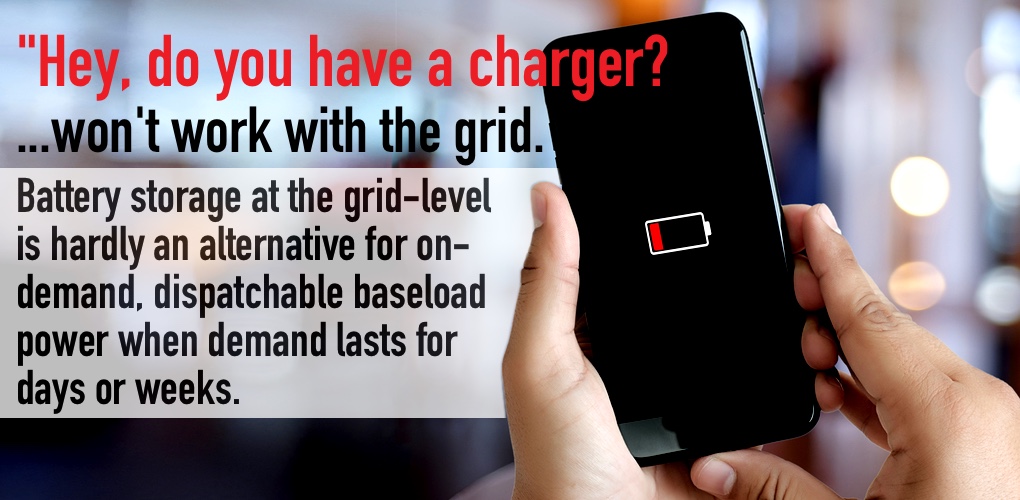
Batteries: Great Promise, Even Greater Hype
Lithium-ion batteries are everywhere. From our smartphones, computers and tablets to electric vehicles, we are in the midst of a battery revolution. But for all the promise of batteries, there are limitations. There are physics problems that dictate how batteries can be used, or should be used, that need to inform our energy policy. Unfortunately, renewables advocates who see energy storage as a silver bullet to solving the intermittency challenges of wind and solar power – are crafting energy policy with grid-scale batteries in a foundational role. That’s a recipe for failure. Here’s why.
The Battery of Tomorrow is Likely the Battery of Today
Lithium-ion batteries were first developed in the 1970s and while they have evolved since, their basic chemistry is the same. The revolution with lithium-ion batteries – the driver to make them ubiquitous in consumer products and now even in cars – is in their manufacturing. Since 2010, the rising scale and improvement of production of lithium-ion batteries has slashed their prices by 85 percent. Tens of billions of dollars have now been invested in mega-factories to produce more of these battery cells and to further drive down their cost. While there are other battery chemistries out there, and some interesting R&D work going on with alternative energy storage approaches, the momentum and infrastructure behind the lithium-ion buildout means the battery of today is almost certainly going to be the battery of tomorrow. And that – when it comes to grid-scale energy storage – is a problem.
Even if battery prices continue to fall, the cost of lithium-ion batteries is just a small piece of the puzzle. Grid-scale battery installations are starting to appear — and they leave much to be desired. They’re typically capable of providing just four hours of electricity. That makes them useful for pushing some of the excess solar power generated during the middle of the day into the evening but it’s hardly an alternative for on-demand, dispatchable baseload power. As former U.S. Energy Secretary Ernest Moniz told Bloomberg News earlier this year, that short-term energy storage can only do so much in integrating renewable power onto the grid. “It’s not going to handle a day, a week, a month, a season,” he said.
What President Obama’s former Energy Secretary is getting at is that batteries are hardly the answer to the massive challenge of wind and solar variability. Yet, renewables advocates, at the state and federal level, are driving policies that would see the grid dominated by renewables backed up by batteries. Small successes do not necessarily translate to wide-scale deployment. Just because you can build a model bridge out of popsicle sticks and glue doesn’t mean you should attempt to replace the Golden Gate with the same approach.
A Limited Role
It should surprise no one that Secretary Moniz’s concerns about batteries are based on hard research. According to analysis from MIT and Argonne National Laboratory, there are steeply diminishing returns when a significant amount of battery storage is added to the grid. The authors of that study found that coupling battery storage with renewables plants is a “weak substitute” for large, flexible and dispatchable coal or natural gas plants.
James Temple of MIT Technology Review summed up the problem this way: “Not only is lithium-ion technology too expensive for this role, but limited battery life means it’s not well suited to filling gaps during the days, weeks, and even months when wind and solar generation flags.” Storing the electricity needed to fill those seasonal gaps in generation requires enormous battery capacity – capacity Temple describes as “astronomically expensive.”
How expensive? In California, for example, building the level of renewable generation and storage necessary to reach the state’s all renewables goals would drive up costs from $49 per megawatt-hour of generation at 50 percent renewable integration to $1,612 at 100 percent. And this calculation assumes lithium-ion battery prices fall to a third of what they are now.
Trying to pursue a national shift to wind, solar and battery storage – such as the approach envisioned by architects of the Green New Deal – is cripplingly expensive. A 2018 study in Energy & Environmental Science found that meeting 80 percent of U.S. electricity demand with wind and solar would require either a nationwide high-speed transmission network or 12 hours of electricity storage for the whole system. A battery buildout that size, at current battery prices, is projected to cost more than $2.5 trillion. Trying to meet 100 percent of U.S. electricity demand with wind and solar would increase those costs exponentially.
Mark Mills, a senior fellow at the Manhattan Institute, wrote, “A grid based entirely on wind and solar necessitates going beyond preparation for the normal daily variability of wind and sun; it also means preparation for the frequency and duration of periods when there would be not only far less wind and sunlight combined but also for periods when there would be none of either.” He continues, “So how many batteries would be needed to store, say, not two months’ but two days’ worth of the nation’s electricity? The $5 billion Tesla ‘Gigafactory’ in Nevada is currently the world’s biggest battery manufacturing facility. Its total annual production could store three minutes’ worth of annual U.S. electricity demand. Thus, in order to fabricate a quantity of batteries to store two days’ worth of U.S. electricity demand would require 1,000 years of Gigafactory production.”
We need a reality check on what role grid-scale batteries can and should play. If batteries are no panacea for wind and solar power’s variability, should we not be very careful about pushing aside the baseload, dispatchable power plants that are the foundation of the grid? The obvious answer is yes.
- On April 17, 2019
